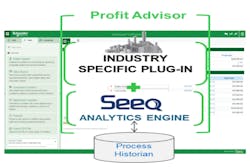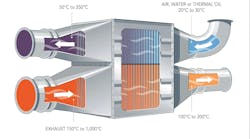Kevin Fitzgerald
Kevin Fitzgerald is a Schneider Electric Fellow and serves as a global solutions architect for the company’s Process Automation business. He has more than 30 years of experience in the process automation and business operations fields, with a focus on the food, pharmaceutical, chemical and energy industries. Fitzgerald joined Schneider Electric as a principal engineer and project manager for the Foxboro Company in 1987. He is a Certified Maintenance and Reliability Professional and has respective certifications from Purdue University and Tufts University in Lean Six Sigma and biochemical engineering. Fitzgerald holds a bachelor’ degree in physics from the College of the Holy Cross and a master’s degree in mechanical engineering from the Massachusetts Institute of Technology. He is an MESA certified ANSI/ISA-95 expert and has published numerous papers and technical articles. He is also a licensed Professional Chemical Engineer in Massachusetts.
Q: How do today’s process control systems focus on improving the efficiency of industrial operations?
Fitzgerald: The Industrial Internet of Things (IIoT) environment brings together connected products, edge control, and advanced apps and analytics to drive new levels of process and operational efficiency. With an open IIoT approach, businesses can digitize and improve intelligence, decision-making capabilities, productivity and efficiency across their enterprises. Today’s advanced process automation systems and software, when coupled with available advanced control and condition monitoring technologies, can deliver excellent results vis-à-vis the efficiency of the operation.
There are also new opportunities for manufacturers to move beyond the traditional focus of solely improving the efficiency of equipment assets and operations to increase production. As the speed of business continues to accelerate, especially as industry variables such as energy and raw material prices fluctuate rapidly, and organizations look at new ways to harness data from stranded or non-instrumented equipment, manufacturers are using IIoT-enabled systems to help move beyond efficiency to better control their operations, health of equipment and business variables. For example, cyber-physical systems, beginning at the equipment layer, can enable real-time control and communication everywhere, meaning plant operators, managers and engineers have the opportunity to measure and improve the profitability of their operations in real time.
Q: What are some of the unrealized or missed opportunities you see related to automation in industrial operations?
Fitzgerald: The real value of the IIoT is that it enables users to control their operational profitability in real time. Because today’s process control systems focus solely on improving the real-time efficiency of the process, everything else is being managed daily, weekly or monthly, what we call transactionally.
But to be successful in today’s market, where business variables can literally change minute to minute, things like safety, environmental safety, reliability and especially profitability have to be controlled in real time too. In order to help customers stop managing their business and actually control it, we have to eliminate the constraints being placed on automation systems.
We strive to help our customers solve their challenges by leveraging technology and expertise to help simplify both how they align system components to specific control domains and how they control their plant assets. With the depth and breadth of our offers, we are uniquely able to put real-time control, interoperability and communication everywhere. This enables our customers to move from controlling only the efficiency of the operation to controlling all those other important real-time business variables, too, especially operational profitability. We call this smart control.
To enable smart control, an empowered workforce is needed to optimize every industrial asset and asset set, essentially offering the knowledge needed to control these domains. Smart control, along with an empowered workforce, combined with an asset-centric automation system completes a control strategy by measuring operational performance — from the asset level to the plant level — in real time.
Q: What are some new IIoT-enabled tools, capabilities and technologies available to industrial organizations?
Fitzgerald: While there are many possible and interesting technology options, companies should also focus on implementing a value-based Industry 4.0 or IIoT offering. Connectivity from connected products, edge control and advanced applications and analytics, coupled with state-of-the-art technologies that include big data and cloud applications, will deliver enhanced value across an enterprise.
IIoT tools available today empower the workforce to control real-time business variables, which means they are more closely involved with and responsible for better business outcomes. New levels of connectivity mean more assets are connected to each other, more people are connected to these assets and more people are connected to each other. Data, once contextualized, can help operators work together to control business performance, not just plant performance.
Today’s increasing speed of business means extracting additional value from control systems is critical to helping end users keep pace and remain competitive. Tools that help the industrial workforce mine historical and real-time data help diagnose and analyze the efficiency and profitability of processes and enable real-time control across operations.
Q: What are some of the challenges that industrial organizations are facing today when it comes to IIoT?
Fitzgerald: Many businesses proceed with IIoT strategies without a clear goal or purpose in mind, but IIoT itself isn’t a value on its own, therefore, businesses must focus on the value they hope to create through the implementation of an IIoT strategy. From there, businesses can execute on an IIoT strategy, concentrating on how to control, not manage, business variables. There are many challenges that face any IIoT initiative. Key among these are project prioritization and scoping, development of a proper business case justification, security of data and asset access and lack of opportunities for supplemental data collection.
Q: Can you talk more about Schneider Electric’s recent partnership with Seeq on your Profit Advisor solution? What is the value of the product for your customers in leveraging IIoT capabilities?
Fitzgerald: By partnering with Seeq, a leading provider of software that enables data-driven decision-making, we’re able to take Profit Advisor to a new level. Unlike other solutions that can only mine historical data, this partnership has provided us with a unique opportunity to present an IIoT software that uses big data analytics to helps customers mine both historical and near-real time data, while performing analytics to visualize business impact of specific assets or operational activities across a plant. Profit Advisor fits well into Schneider Electric’s EcoStruxure framework. Profit Advisor provides the means to allow connected products and existing automation and control systems to become the profit engine of a business, providing the means to stop managing performance on a set schedule and actually control it in real time.
At Schneider Electric, we believe an empowered workforce makes better business decisions. Profit Advisor determines how each action and asset affects real-time operational profitability and potential savings, enabling a 3 percent improvement in production value and 5 percent reduction in cost per year.
This has been echoed recently according to Craig Resnick, vice president at ARC Advisory Group. According to Resnick, "Despite all the new technology, many industrial operations are still performing sub-optimally when it comes to the potential business value. Optimizing business value in industrial operations requires scalable, open solutions that help users leverage every industrial asset. Such an approach could ultimately enable the industry to move from monitoring business value to actually controlling it. This ability to actually control business value in industrial operations is a real breakthrough and will result in direct positive effects to companies’ bottom lines."
Developed through a partnership with SEEQ, a leading provider of software and services that enable data-driven decision-making, EcoStruxure Profit Advisor uses big data analytics to measure the financial performance of an industrial operation in real time, from the plant equipment level up to the process unit, plant area, plant site and enterprise levels. On-premise or cloud-enabled, it works seamlessly with any process historian to mine both historical and real-time data. It then processes that data through Schneider Electric’s proprietary segment-specific real-time accounting algorithms to determine operational profitability and potential savings.
The benefits of Ecostruxure Profit Advisor are measurable and have been quantified across many industry segments. These benefits, often associated with the operational empowerment of the workforce, can be associated with improved production value (i.e. producing more valued/sellable product for an existing set of industrial assets) or reduced energy and material cost (i.e. reduction or curtailment of the energy needed to produce a given product on a set of industrial equipment or assets, which also refers to improving the yield of sellable finished goods from starting raw materials).
When more is sold for less overall cost, the result is increased operational profitability. For instance, industries as diverse as hydrocarbons/petrochemicals to mineral processing, can see between 4 and 5 percent increases in production value that can translate to $20 to $25 million of benefits in operational profit. The same is true at the percentage level for many other sectors, which has been demonstrated in numerous real-time accounting studies over the years.




